Brewing coffee with a French press is simple and satisfying.
This method, known for its bold and full-bodied flavor, transforms your coffee experience.
Using a French press is not only easy but also cost-effective.
With just a few steps, you can enjoy a rich, delicious cup of coffee right at home.
Whether you’re a coffee novice or a seasoned aficionado, the French press is a fantastic tool to add to your kitchen arsenal.
Ready to learn how? Let’s dive in.

How To Brew Coffee In A French Press: At A Glance
- Step 1: Preheat the French Press
- Step 2: Add Coffee Grounds
- Step 3: Bloom the Coffee
- Step 4: Add Remaining Water and Steep
- Step 5: Press and Pour
What is a French Press?
A French press is a straightforward coffee brewing device that uses a cylindrical pot with a plunger and a built-in filter screen.
The coffee grounds are fully immersed in hot water and then separated by pressing the plunger down, trapping the grounds at the bottom.
This method allows for a full extraction of flavors, resulting in a rich and robust cup of coffee.
The French press has an interesting history.
The first known design was patented in 1852 by the French inventors Mayer and Delforge.
However, it wasn’t until 1929 that the Italian designer Attilio Calimani patented a more modern version of the device.
Later, in the 1950s, a Swiss entrepreneur named Faliero Bondanini refined the design, which led to the popular model we know today.
Around the world, the French press is known by several different names.
In England and France, it’s called a “cafetiere.”
In New Zealand, Australia, and South Africa, it’s referred to as a “coffee plunger.”
In some places, it’s also known as a “press pot.”
Despite the different names, the French press’s method and the delicious coffee it produces remain consistent globally.
Choosing Your Equipment
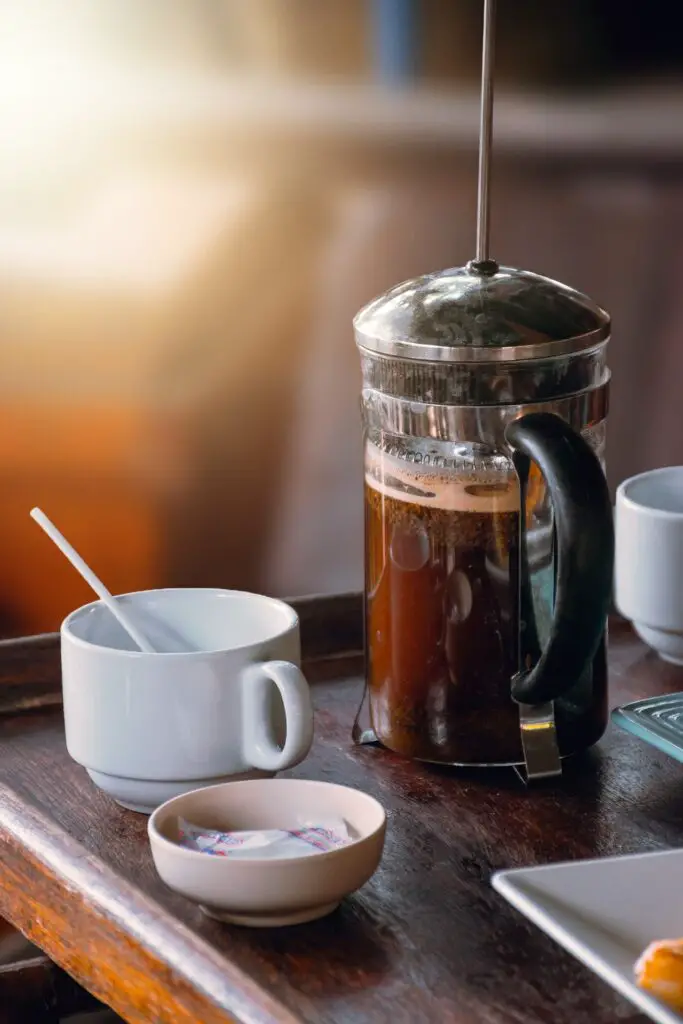
French presses come in various materials, each with its own benefits.
Glass French presses are popular for their classic look and ability to see the brewing process.
They are often made with heat-resistant borosilicate glass, which is durable and keeps the coffee hot.
However, they can be fragile and may break if dropped.
Stainless steel French presses are known for their durability and heat retention.
They are less likely to break and keep coffee warm for longer periods.
Stainless steel models are perfect for those who want a sturdy and reliable option.
Ceramic French presses are less common but offer excellent heat retention and come in various stylish designs.
They add a touch of elegance to your kitchen but can be heavier and more fragile than stainless steel.
Double-walled French presses provide superior insulation, keeping your coffee hot for longer.
These models are usually made from stainless steel and are ideal for those who enjoy sipping their coffee slowly without it cooling down too quickly.
When it comes to recommended brands, Bodum Chambord is a classic choice known for its high-quality glass and stainless steel models.
Bodum has been making French presses for decades and is trusted by coffee enthusiasts worldwide.
Another excellent brand is Espro Press.
Espro Press offers advanced filtration systems, ensuring a clean cup of coffee with minimal grounds.
Their double-walled stainless steel models are particularly praised for their heat retention and durability.
Selecting the Right Coffee Beans
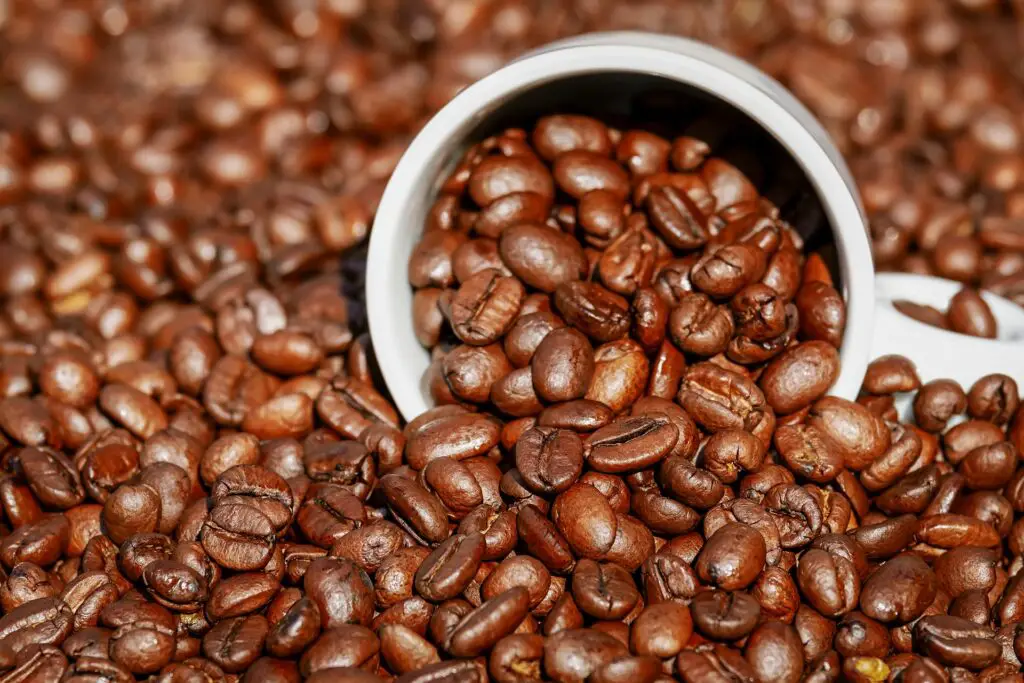
Choosing the right coffee beans is crucial for brewing a perfect cup of French press coffee.
Fresh, high-quality beans make a noticeable difference in flavor and aroma.
Always opt for freshly roasted beans, as they retain more of their natural oils and flavors compared to older beans.
Using fresh beans ensures a vibrant and rich taste in every cup.
When it comes to roast levels, medium to dark roasts are recommended for French press coffee.
Medium roasts provide a balanced flavor with a good mix of acidity and body.
They highlight the beans’ natural characteristics while still offering a rich, smooth taste.
Dark roasts, on the other hand, are known for their bold, intense flavors and lower acidity.
They bring out deep, robust notes that are perfect for a full-bodied French press coffee.
Proper storage of coffee beans is also essential to maintain their freshness and flavor.
Store your beans in an airtight container to protect them from exposure to air, moisture, and light.
A cool, dark place, like a pantry, is ideal for storage.
Avoid storing coffee beans in the refrigerator or freezer, as this can introduce moisture and affect the beans’ quality.
Grinding Your Coffee Beans

For the best results, use a coarse grind, similar to the texture of sea salt.
This allows for even extraction and prevents the grounds from slipping through the mesh filter, resulting in a cleaner cup of coffee.
Using the right equipment to grind your beans is essential.
A burr grinder is highly recommended over a blade grinder.
Burr grinders provide a consistent grind size, ensuring even extraction and better flavor.
They allow you to control the coarseness of the grind precisely.
On the other hand, blade grinders chop the beans unevenly, leading to an inconsistent grind and potential over-extraction or under-extraction.
Adjusting the grind size can help you achieve the optimal flavor.
If your coffee tastes too bitter, try a coarser grind.
If it’s too weak, a slightly finer grind may be needed.
Experimenting with different grind sizes allows you to tailor the coffee to your taste preferences.
Always remember that the grind size should be coarse enough to avoid clogging the French press filter but fine enough to extract the rich flavors of the beans.
Measuring Coffee and Water
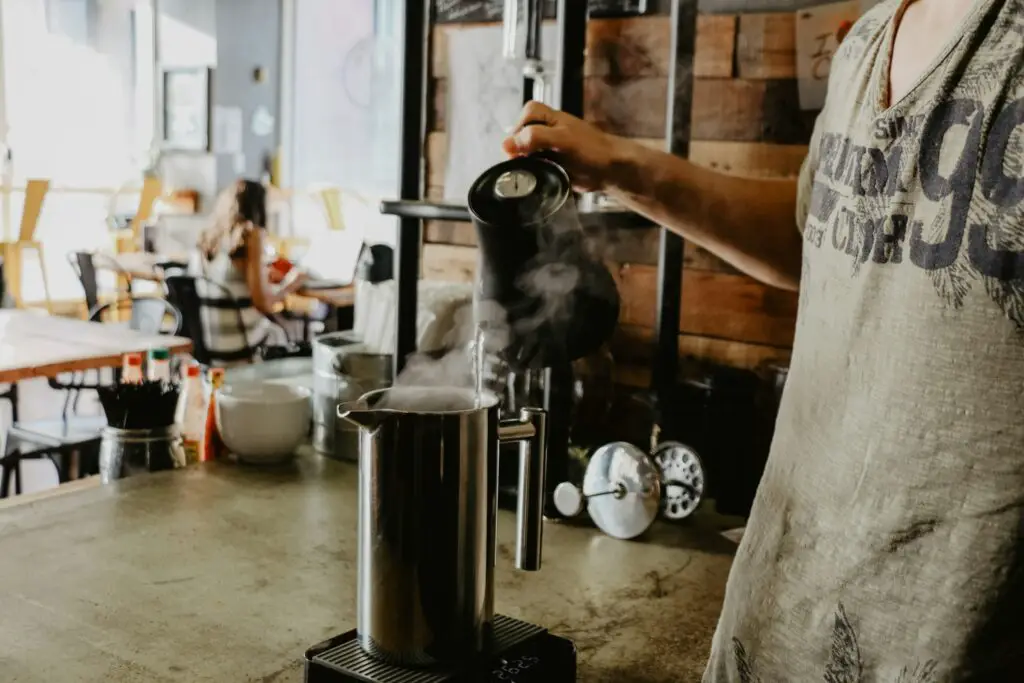
The standard ratio is 1:15 or 1:16, which means one part coffee to fifteen or sixteen parts water.
This ratio yields a balanced cup that’s not too strong or too weak.
For those who prefer a stronger brew, a 1:12 ratio works well.
Using a kitchen scale ensures accuracy in measuring your coffee and water.
Weighing your coffee grounds instead of using scoops helps maintain consistency and precision.
For example, if you’re brewing a standard 32-ounce French press, you’ll need about 60 grams of coffee and 900 grams of water for a 1:15 ratio.
Adjust the amounts based on your preferred ratio and the size of your French press.
Accurate measurement of coffee and water leads to a more predictable and enjoyable coffee experience.
Heating the Water
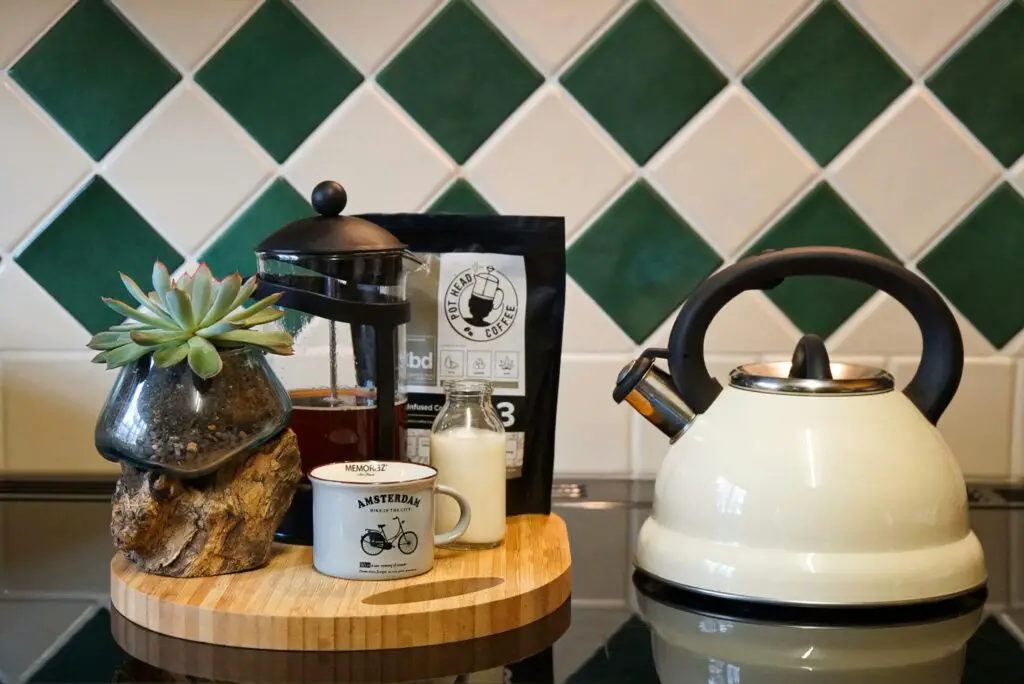
Achieving the right water temperature is essential for brewing the perfect French press coffee.
The optimal range is between 195°F and 205°F.
Water that’s too hot can scorch the coffee grounds, leading to a bitter taste.
Water that’s too cool can result in under-extracted, weak coffee.
To reach the ideal temperature, start by bringing your water to a full boil.
Once it reaches boiling point, remove it from the heat and let it cool for about 30 seconds.
This brief cooling period typically brings the temperature down to the optimal range.
If you want more precision, consider using a kitchen thermometer to check the water temperature.
Alternatively, electric kettles with adjustable temperature settings can heat water to the exact desired temperature, eliminating the guesswork.
The Brewing Process
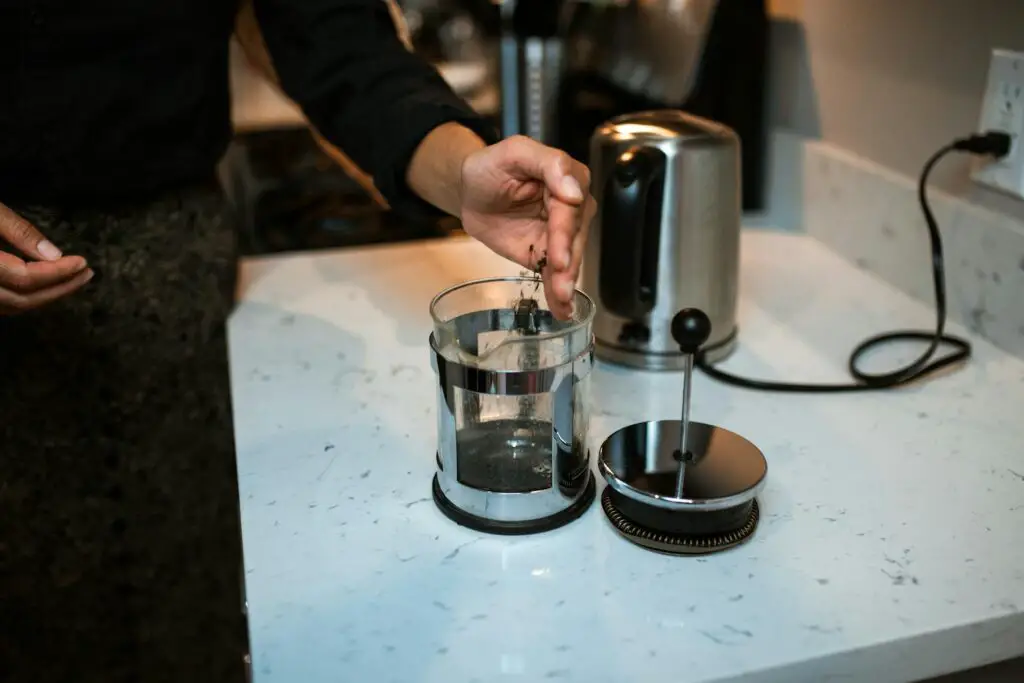
Step 1: Preheat the French Press
Start by preheating your French press.
Pour hot water into the press and swirl it around to warm up the glass or metal.
This helps maintain the brewing temperature.
Once the press is warm, discard the water.
Step 2: Add Coffee Grounds
Next, add your measured coffee grounds to the preheated press.
Ensure you use coarsely ground coffee for the best extraction.
As mentioned earlier, the grounds should resemble coarse sea salt.
Step 3: Bloom the Coffee
Pour a small amount of hot water over the coffee grounds, just enough to saturate them.
Stir gently to ensure all the grounds are wet.
Let the coffee bloom for about 30 seconds.
This process releases trapped carbon dioxide and enhances flavor extraction.
Step 4: Add Remaining Water and Steep
After blooming, fill the press with the remaining hot water.
Stir the mixture once to ensure the grounds are evenly saturated.
Place the lid on the French press with the plunger pulled up.
Allow the coffee to steep for about 4 minutes.
You can adjust the steeping time based on your taste preference—longer for a stronger brew, shorter for a milder one.
Step 5: Press and Pour
Once steeping is complete, press the plunger down slowly and steadily.
Apply even pressure to avoid agitating the grounds.
Pour the brewed coffee immediately into a carafe to prevent over-extraction, which can make the coffee bitter.
Enjoy your rich, full-bodied French press coffee!
Serving and Enjoying Your Coffee
After pressing, it’s time to serve and enjoy your freshly brewed French press coffee.
Here are some tips to enhance your coffee experience.

Tips for Serving
Pour your coffee immediately after pressing to prevent over-extraction, which can make the coffee taste bitter.
Use pre-warmed cups to help maintain the coffee’s temperature.
Adding a touch of warm milk or cream can balance the bold flavors if you prefer a creamier texture.
For an extra touch, sprinkle a bit of cinnamon or cocoa powder on top.
Storing Extra Coffee
If you have leftover coffee, transfer it to a thermos.
This helps maintain the temperature and flavor for a longer period.
Avoid leaving coffee in the French press, as it will continue to brew and become overly strong and bitter.
A good thermos can keep your coffee warm and enjoyable for several hours, making it convenient for those who like to sip throughout the day.
Cleaning and Maintenance
Keeping your French press clean is essential for consistently great-tasting coffee.
Here’s how to properly clean and maintain your French press.
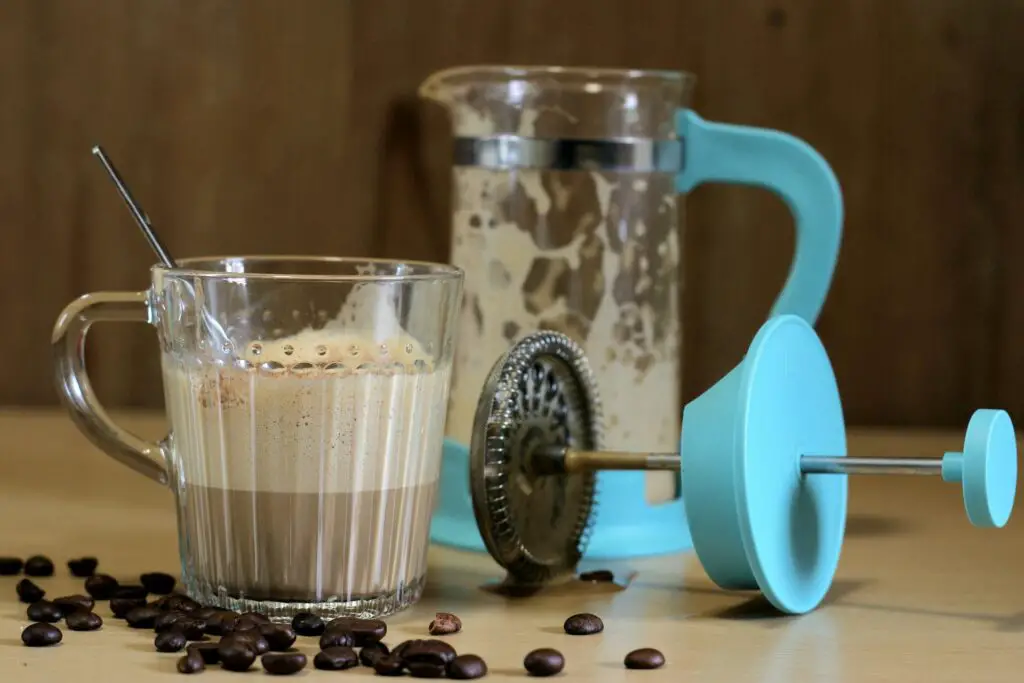
How to Clean the French Press
Start by disassembling the French press.
Remove the plunger and separate the filter screens.
Discard the used coffee grounds—it’s easiest to tap them into the trash or compost.
Rinse all parts under warm water to remove any residual grounds.
Tips for Easy Cleanup
For thorough cleaning, use a mild detergent.
Gently scrub the carafe, plunger, and filter screens with a soft sponge or brush.
Be sure to reach all crevices where coffee oils can build up.
Rinse everything well to ensure no soap residue remains, which can affect the taste of your coffee.
To dispose of the coffee grounds easily, consider using a sink strainer or composting them.
Regularly clean your French press after each use to prevent buildup and maintain optimal flavor.
For a deep clean, occasionally soak the components in a mixture of water and vinegar.
Troubleshooting Common Issues
Even with the right technique, you might encounter some common issues when brewing coffee with a French press.
Here’s how to troubleshoot and resolve them.

Bitterness (Over-extraction)
If your coffee tastes bitter, it’s likely due to over-extraction.
This happens when the coffee grounds are in contact with water for too long.
To fix this, reduce the steeping time.
Aim for 4 minutes, and adjust based on your taste preferences.
Additionally, check your grind size—if the grounds are too fine, it can lead to over-extraction.
Make sure you’re using a coarse grind.
Weak Coffee (Under-extraction)
Weak coffee is often a result of under-extraction, which means the coffee hasn’t brewed long enough or the grind size is too coarse.
Ensure you’re steeping the coffee for the full 4 minutes.
If the coffee still tastes weak, try using slightly finer grounds.
Be careful not to go too fine, as this can cause over-extraction and bitterness.
Grounds in the Coffee (Improper Grind Size)
Finding grounds in your coffee is usually due to an improper grind size.
If the grind is too fine, it can slip through the filter.
Use a coarse grind to prevent this issue.
Additionally, ensure that your French press filter is properly assembled and in good condition.
Regularly check the filter screens for any wear and tear, and replace them if necessary.
Experimenting with French Press Coffee
Brewing coffee with a French press offers a lot of flexibility.
By adjusting various factors, you can tailor your coffee to suit your personal taste.
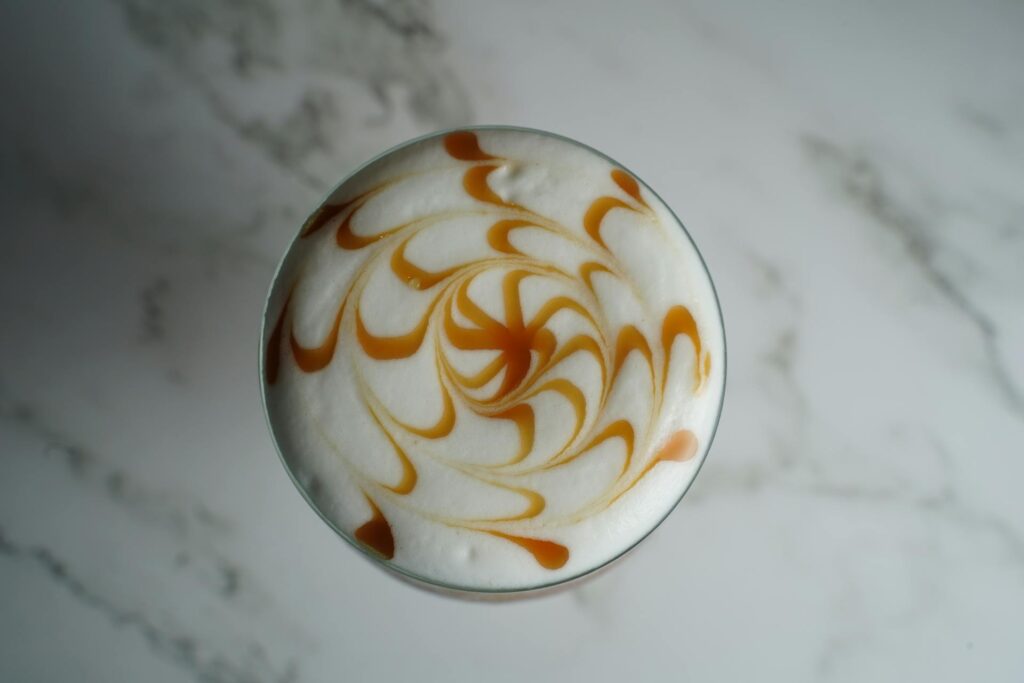
Adjusting Variables
One way to experiment is by tweaking the grind size.
A coarser grind will produce a cleaner, less intense flavor, while a finer grind can result in a stronger, richer brew.
Just be careful not to go too fine, as it can lead to over-extraction and bitterness.
Water temperature also plays a significant role.
While the optimal range is 195-205°F, you can experiment within this range to see how slight changes affect the flavor.
Using water on the lower end of the spectrum might produce a milder cup, whereas hotter water can extract more intense flavors.
Steeping time is another variable to adjust.
The standard 4-minute steep is a good starting point, but you might prefer a slightly shorter or longer steep.
A shorter steeping time will result in a lighter coffee, while a longer time will yield a stronger, more robust flavor.
Adding Flavors
Enhance your French press coffee by adding different flavors.
Spices like cinnamon, nutmeg, or cardamom can add a warm, aromatic touch.
Simply add a pinch to the grounds before brewing.
Flavored syrups are another way to add a new dimension to your coffee.
Vanilla, caramel, or hazelnut syrups can sweeten and enrich the flavor.
Add a small amount to your cup after brewing and adjust to taste.
Benefits of French Press Coffee
Using a French press to brew your coffee offers several unique benefits, both for your health and the environment.

Health Benefits
French press coffee retains the natural oils from coffee beans, which are often filtered out in other brewing methods.
These oils are rich in antioxidants, which help combat free radicals in your body, potentially reducing the risk of chronic diseases.
The full immersion method of brewing ensures that these beneficial compounds are extracted and present in your cup.
Furthermore, the French press method allows for better control over the brewing process, meaning you can use freshly ground, high-quality coffee beans.
Fresh coffee beans are not only more flavorful but also pack more nutritional benefits compared to pre-ground coffee.
Environmental Benefits
One of the significant environmental benefits of using a French press is that it doesn’t require paper filters.
This reduces waste and helps save trees.
Unlike single-use paper filters, the metal mesh filter in a French press is reusable, making it a more sustainable option.
Additionally, French presses are typically durable and long-lasting.
With proper care, a French press can last for many years, reducing the need for frequent replacements and thus minimizing environmental impact.
Conclusion
Brewing coffee with a French press is a simple and rewarding process.
By following the steps outlined, you can enjoy a rich, full-bodied cup of coffee.
Remember to experiment with grind size, water temperature, and steeping time to find your perfect brew.
Enjoy the journey of discovering the best cup of French press coffee tailored to your taste!
FAQ’s
How much coffee do you put in a French press?
For a standard 1:15 coffee-to-water ratio, use 1 gram of coffee for every 15 grams of water.
For an 8-cup (34-ounce) French press, this translates to about 56 grams (8 tablespoons) of coffee grounds.
How long to leave coffee in French press before pressing?
Leave the coffee to steep for about 4 minutes.
This time can be adjusted based on your taste preferences.
A shorter steeping time results in a lighter brew, while a longer time yields a stronger, more robust flavor.
What is the golden ratio for French Press coffee?
The golden ratio for French press coffee is typically 1:15.
This means 1 part coffee to 15 parts water.
For a stronger brew, you can use a 1:12 ratio.
How hot should coffee be for a French press?
The optimal water temperature for French press coffee is between 195°F and 205°F.
If you boil the water, let it cool for about 30 seconds before pouring it over the coffee grounds to reach the ideal temperature.


